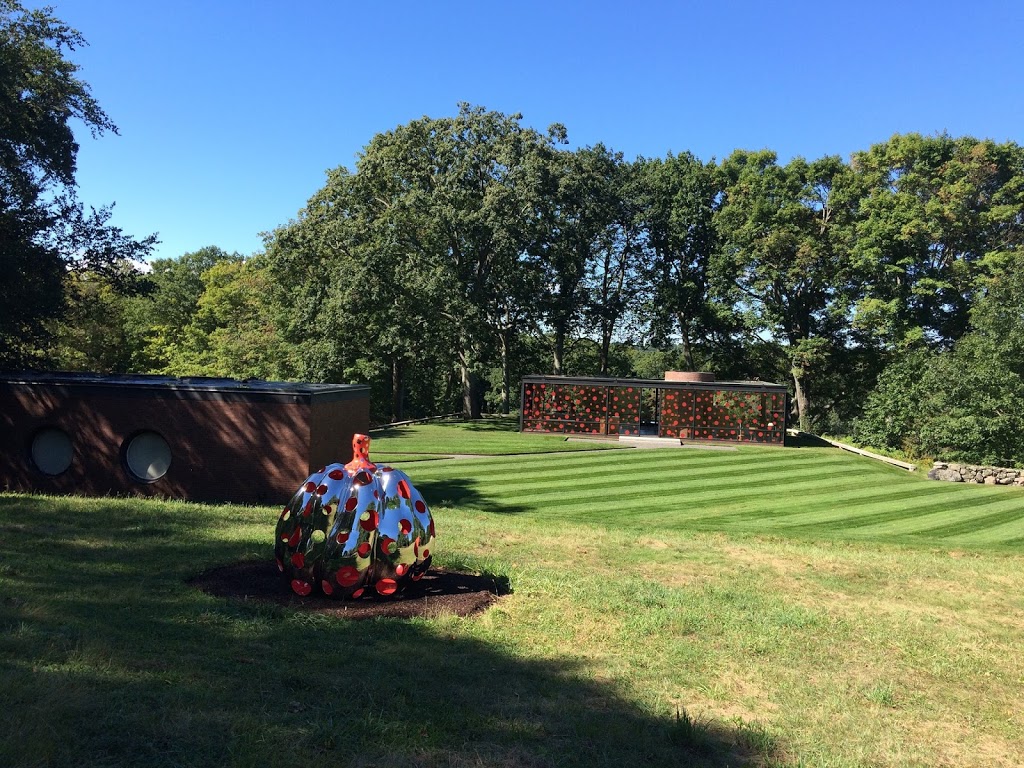
Follow the Dots and Reflect on the Beauty of Yayoi Kusama’s Art
 |
| Philip Johnson’s Glass House in New Canaan, Connecticut, with the Guest House and Yayoi Kusami’s Pumpkin |
Yayoi Kusama is now the featured artist as the Hirshhorn Museum and Sculpture Garden. Crowds are lining up out the door to see her exhibition, “Infinity Mirrors.” It’s a blockbuster show made up of mirrors and dots that’s capturing the public imagination with huge crowds.
 The polka dots of Yayoi Kusama are much the same. They’re small pinpricks in the center of something much larger. In reflecting on the dots, and in experiencing a multiplicity of dots, we become aware of the universe much larger than ourselves. We go outside of ourselves, into the larger universe. Presumably the Hirshhorn exhibition will make that world seem infinite and thus the title, “Infinity Mirrors.”
The polka dots of Yayoi Kusama are much the same. They’re small pinpricks in the center of something much larger. In reflecting on the dots, and in experiencing a multiplicity of dots, we become aware of the universe much larger than ourselves. We go outside of ourselves, into the larger universe. Presumably the Hirshhorn exhibition will make that world seem infinite and thus the title, “Infinity Mirrors.”
The difference between Kusama’s installations at The Glass House and in “Infinity Mirrors” is the difference between seeing the expansiveness of life in nature and being inside of our own small world and being forced to expand outward. The Hirshhorn is expecting an explosion of “selfies” taken at the exhibition. Visitors will only be allowed in the six installation rooms, with the doors closed, for a limited amount of time.
 |
| Pumpkin on the grounds of The Glass House |
Kusama displayed one of her large pumpkins on the grounds of the Glass House. The metal sculpture was pierced with polka dots and has a red interior. Kusama’s pumpkin theme repeats in one of the six installation rooms of the the Hirshhorn Exhibition. It’s an installation called “All the eternal love I have is for the pumpkins.” (One of these glass pumpkins broke last Saturday, forcing a temporary closing of the exhibit.)
 |
| The photo by Domus was taken in November, 2016 |
Pumpkins, like the polka dots, are a lifelong obsession for the artist. According to Kusama, “In Japanese, a ‘pumpkin head’ is an ignorant man or a pudgy woman, but for me, I am charmed by its shape, form, and lack of pretension.” There’s a humor in Kusama work, too.
The Glass House’s Kusama installation also featured mirrors in an entirely different form — different from those at the Hirshhorn. They were spherical balls in a pool of water called Narcissus Garden, surrounding the Pond Pavilion designed by Johnson. They spheres, 1300 of them, each 30 cm wide, moved and floated with the ponds currents. They reflected the sky, the water and land. Like Monet’s Water Lilies, Kusama’s water art unifies the elements of water, earth and air, except that it’s not done in a series of paintings. Its a form of kinetic sculpture. In it’s effervescence, Narcissus Garden reminds me that some things can never appear the same again.
 |
| Philip Johnson’s Pond Pavilion and Yayoi Kusama’s Narcissus Garden, September 24, 2016, view from above |
Kusama, born in 1929, is now 87. She moved from Japan to New York in 1957 and played an important role in the avant-garde movement of the ’60s. She participated in events with Yoko Ono, Nam June Paik, Charlotte Moorman and Allan Kaprow, instances of performance art called “happenings.” But in 1973 she moved back to Japan, exhausted and suffering from hallucinations. She has lived in a mental institution since that time. There was a rebirth of interest in her art in the late ’90s. Her work perfectly embodies Pop Art and Conceptual Art, bridging the two movements, as well as Environmental Art and Performance Art.
The public appreciation for installations and Conceptual Art has finally risen, giving her the broad audience she has today. The Hirshhorn Show is a retrospective celebrating 50 years of her life as an artist. It will travel to four other museums around the US and Canada. Sometimes it takes a life time of work and struggle to finally achieve what you’re here for and today is her time. (The Narcissus Garden is a variation she had introduced years ago at the Venice Biennale in 1966. The “Infinity Mirrors” concept actually goes back in Art History, used in the Hall of Mirrors and integrated into the design of the Palace at Versailles.)
 |
| Yayoi Kusama |
According to art critic Philip Kennicott, Kusama says, “My art originates from hallucinations only I can see. I translate the hallucinations and obsessional images that plague me into sculptures and paintings.” Is it a combination of the obsessiveness in OCD and the hallucinations of schizophrenia? If it is mental illness that creates this great art, then we can recognize mental illness as a special gift and not stigmatize these people who suffer from it. (Read Philip Kennecott’s Review. He sees her as criticizing the art world’s narcissism. I believe that criticism is justified.)
(The best article on the Glass House exhibition is from DeZeen.)


Recent Comments